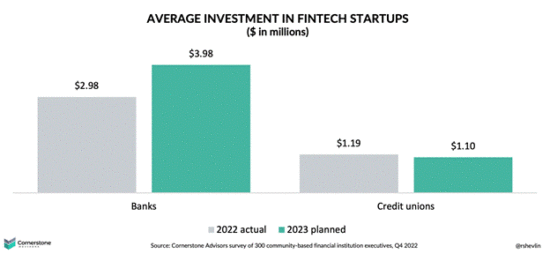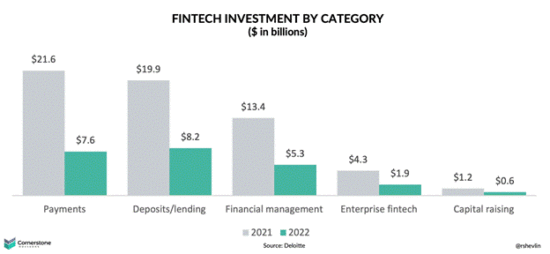

Fintech startups looking for funding in 2023 are finding that it isn’t as easy as it was a few years ago.
According to CB Insights, fintech funding in the U.S. totaled $3.9 billion in Q4 2022, down 79% from Q4 2021. The total number of deals funded dropped from 423 in Q4 2021 to 342 in Q4 2022, representing a 73% decline in the average funding amount per raise from $43 million down to $11.4 million.
Not all venture capitalists (or VCs) are cutting back on investing, however.
In fact, not all providers of venture capital are venture capitalists. Increasingly, banks are filling the void created by VCs. And not just the large megabanks.
According to Cornerstone Advisors’ What’s Going On in Banking 2023 study, there are about 500 community banks and credit unions making direct investments into fintech startups.
Among community banks investing in fintech startups, the average investment was nearly $3 million per bank in 2022. That figure is expected to grow by about a third to roughly $4 million in 2023.

Overall, Cornerstone Advisors estimates that community banks and credit unions will pump about $1.5 billion in capital into fintech startups in 2023.
Banks aren’t necessarily investing in all categories of fintechs, however. Most investments are in a segment of fintechs called “enterprise fintech,” which Blackrock defines as:
“Software and platforms for financial institutions that streamline and/or automate operational and business processes.”
In other words, fintechs whose products and services can help financial institutions—not disrupt or displace them.
Deloitte estimates that this category of fintechs attracted $1.9 billion in funding in 2022, down from $4.3 billion in 2021.

In 2023, community banks alone will account for two-thirds to three-quarters of the total 2022 funding for the enterprise fintech category.
Many of the banks making fintech investments are doing so through firms specifically designed to help the institutions identify and vet potential investment candidates and to manage their investments including:
Banks should follow a number of best practices when making fintech investments:
Banks need to be clear about their business objectives for investing and what they expect in return—which is more than just a return on investment. It might be to explore a new segment, build a new product or deepen a relationship. Jason Henrichs, CEO of Alloy Labs Alliance, cautions:
“Don’t expect investing to solve your strategic problems. The investment extends beyond the checks written—the board needs to invest significant energy into defining the objectives, the senior leadership team needs to create an investment strategy, and the operational team needs to build the infrastructure to extract strategic value.”
Carey Ransom, managing director of BankTech Ventures, adds:
“Banks need to start with a vision of what it will look like in a few years, what ‘community’ (not necessarily a geographic community) they can best serve, and what capabilities they need to invest in and develop. Much of the change will involve fintech investments and a culture and team that understand how this will best serve their customers and the bank’s business.”
According to Henrichs, banks as VCs need to define: a) which segments or deal profiles they’ll focus on; b) how much they plan to invest over a defined time period; c) their comfort level with losses; d) how many startups will be in their portfolio; and e) what stage(s) they want to invest in.
Where will deals come from? Who will do due diligence? Who makes the investment decision? Who’s responsible for ensuring that strategic objectives are met? Joe Maxwell, managing partner at JAM FINTOP, counsels banks that they need to define a point person for the fintechs to interact with. In addition, Maxwell warns banks that:
“The board of directors and senior leadership team must have tech savvy folks—it’s an imperative. It’s hard to support a VC approach if the board and executive team can’t articulate the ‘why’ behind the investments.”
Maxwell believes that banks that are “honest about their technology stack and operational costs make better investment decisions because they chase fewer shiny objects, can better articulate their pain, and better identify a technology fit.”
Lastly, there’s strong consensus (unsurprisingly) from the experts that banks shouldn’t lead deals, but, instead, bring in a partner VC firm to put together the pricing and deal structure and do the due diligence. It might sound self-serving, but as BankTech Venture’s Ransom says:
“Knowing how startups work and how to invest in them are specialized skills and knowledge that are typically achieved through a lot of learned experience, so tend to naturally lend themselves to partnership from a bank’s perspective.”
For a complimentary copy of Cornerstone Advisors’ 2023 What’s Going On In Banking study, click here.